 Features
Features
Picó sound systems: The beating heart of Colombian bass culture is on its way to global impact
Originating in the 1950s, Colombia’s beloved picó sound systems power some of the most raucous parties in the world, known for an experimental blend of sounds, fierce picotero rivalries, and their own mythology and visual aesthetics. Though there have been repeated attempts to suppress picó culture over the years, the attitudes of authorities and mainstream cultural institutions have started to change, and the associated music styles are connecting with new generations of fans at home and abroad. Wil Crisp reports
It’s 8.40PM on Sunday, February 11, in Barranquilla’s Carrera 50 street and two of Colombia’s biggest picó sound systems are set up next to each other, during the city’s month-long carnival, going head-to-head pumping out bass-heavy rhythms at brain-scrambling volume.
El Super Kike is a leader of the new school, blasting a dizzying array of genres with original productions of champeta urbana and guarapo at the heart of its sound.
About 40 metres down the road, the flamboyantly-painted El Gran Lobo represents the classic sound and values of Colombia’s traditional bass-heavy “turbo” sound systems - with salsa and genres from Africa like Congolose soukous as the bedrock of the selections from the picotero, the owner of the sound system.
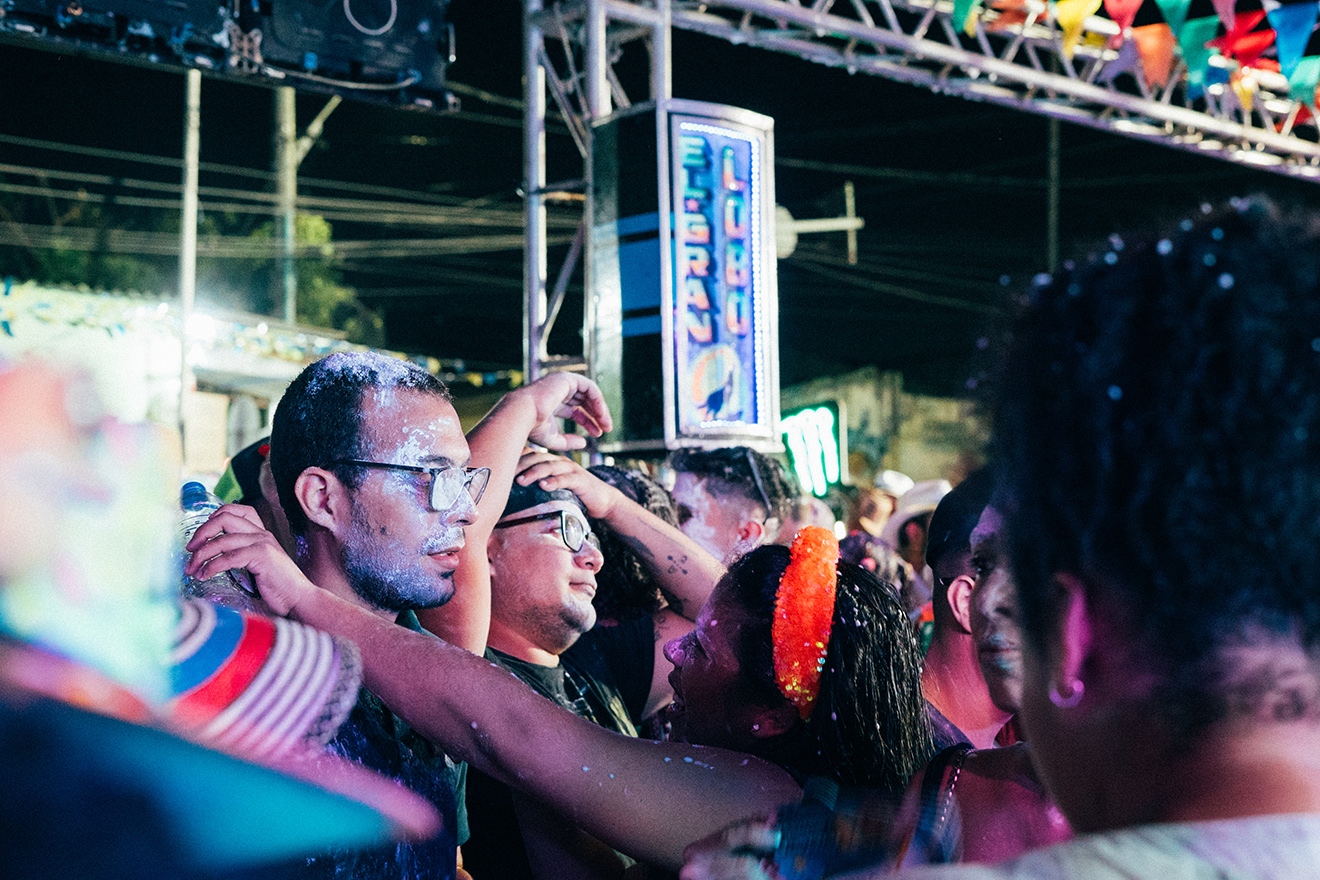
In front of the El Super Kike speaker stack people are packed so densely in some parts of the street it’s impossible to move. The crowd is hot and humid. Dancers are pressed against each other as they are vibrated by bass from the 20-foot high stacks. They are sticky with sweat, splashes of beer and aguardiente.
Some are dressed flamboyantly in wide-brimmed hats and densely patterned, brightly coloured shirts. Others look more utilitarian, wearing faded T-shirts and cutoff jeans, as if they came to dance and they knew it was going to be messy.
Here and there, partygoers have climbed up small trees to escape the sea of dancers. They are swaying in the branches above hawkers selling drinks out of big bins of ice.
Some of the shops that line the street are boarded up to stop potential damage while others have risked staying open and are doing a brisk trade selling beers and snacks with handwritten cardboard signs advertising special offers.
As the ’80s champeta track ‘Tatiana’ by Zitany Neil blasts out of the sound system the picotero standing between the speaker stacks is scatting live over the microphone on top of the track while the arms and legs of dancers flail in the crowd.
Though their styles are very different, both El Super Kike and El Gran Lobo are at the forefront of a scene that has been central to the musical identity of Colombia’s Caribbean coast for more than 40 years – and is starting to gain more recognition, both at home and on an international level.

Decades of bass
Picó culture is firmly rooted in the barrios of the coastal cities of Cartegena, Barranquilla, and Santa Marta. It is believed that picó sound systems first started being built in Colombia in the early 1950s before becoming a ubiquitous fixture at the heart of musical culture in the country’s Caribbean coast in the 1970s.
During the ’70s, the explosion in sound system parties was fuelled by a frenzy of crate-digging and an influx of imported African records that would be played side-by-side with domestically produced vallenato and salsa along with imported tunes from Cuba.
During this period, competition became intense with picoteros going to great lengths to boost the power of their sound systems and track down rare records, often making use of relatives that worked for airlines to gain access to gold dust records from Africa.
Read this next: Colombia's after-hours scene is an anarchic, cultural melting pot
It became common practice for picoteros to scratch the labels off their vinyl and rename them with titles of their own invention to stop the competition from identifying the “exclusivos”.
One of the most famous examples of this is the tune ‘Zangaléwa’ by the Cameroonian makossa group Golden Sounds, which was known as ‘El Militar’ in the barrios of Barranquilla, and was later sampled by the Barranquilla native Shakira in her 2010 song ‘Waka Waka’.
Monosoniko, a DJ from Baranquilla whose sound was forged in the Caribbean coast’s picó culture, says that, historically for picoteros, no genre has been off-limits.
“It’s all about the vibe,” he says. “Certain genres might form the foundation of your set, but picoteros will generally take a tune from any genre and play it in their set as long as they think the vibe is right.
“This means that you can even hear tunes like Arabic music or American rock dropped into sets – if the picotero feels like it fits in for some reason.”
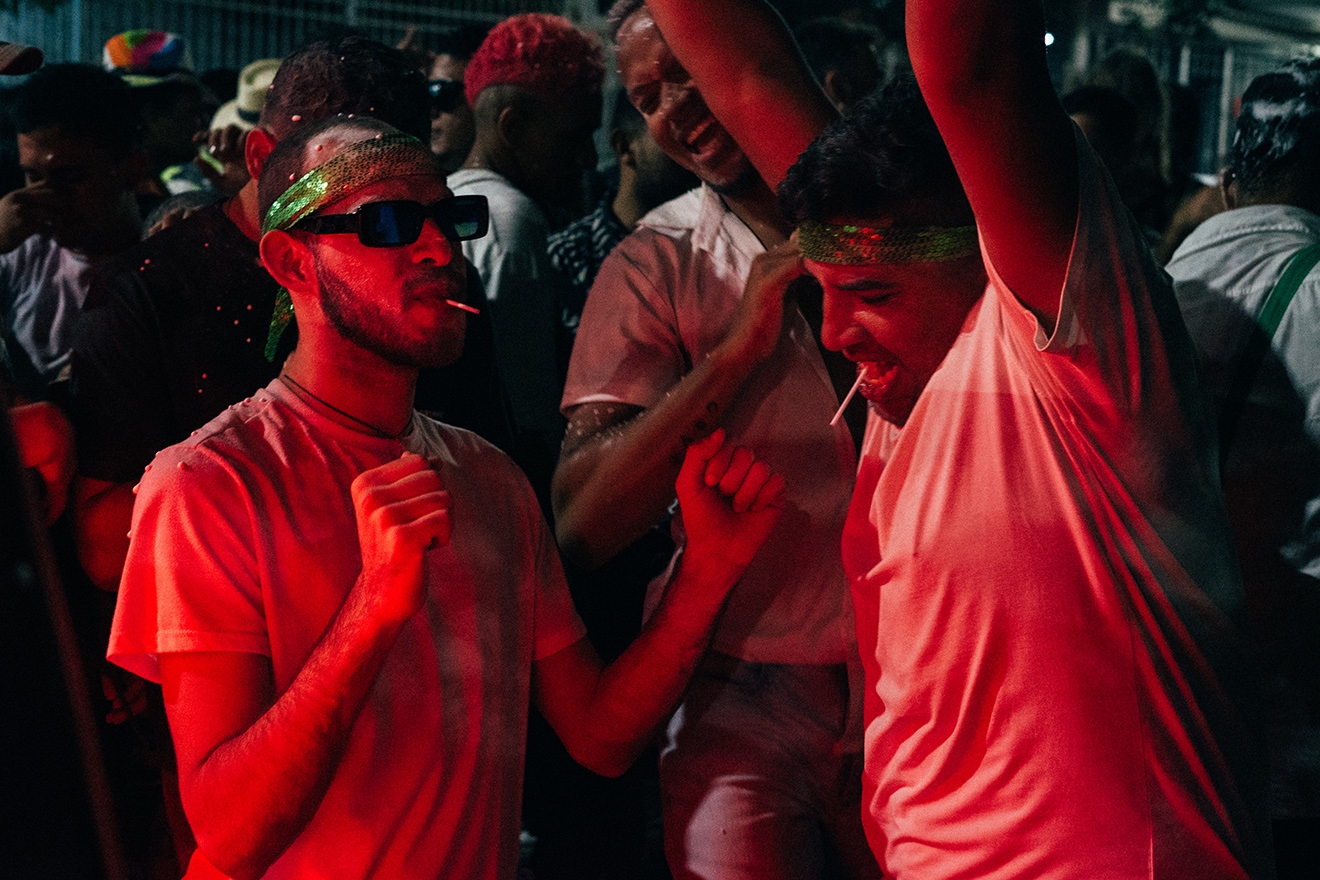
In the late ’80s there was a split in the culture as new technologies and the increasing influence of East African soukous added a harder edge to some sound systems, such as the innovative El Timbalero sound system.
The use of samplers was rejected by many picós, but for those that followed in their footsteps of the likes of El Timbalero, technology-driven audio experimentation became a cornerstone of their ethos.
Subsequently, the Casio SK-5 sampling keyboard (which hit the market in 1987) became a genre-defining instrument for champeta urbana, and later guarapo, just as the Roland TB-303 is to acid house.
Read this next: The history of acid house in 100 tracks
Artists like DJ Rata Piano and El Pulpo played a key role in taking champeta to strange new sonic territories. Both used the SK-5 in parallel with Yamaha DD drum machines to create frenetic live shows combining African and Latin sounds with elements from unlikely Western genres like high-energy commercial dance music and trance.
In this era Barranquilla became a pressure cooker of electronic experimentation and produced some very strange output, including a subgenre of rowdy electronic champeta focusing on cartoon shows. This included tracks like ‘Las Tortugas Ninjas Remix’ by El Melchor, paying homage to Teenage Mutant Ninja Turtles, and Beto Man’s ‘Los X-Men’.
Over decades of fierce competition and evolution, pico culture developed a profound musical depth, with its own mythology, traditions, and visual aesthetic. Picoteros amassed vast collections of world music and local musicians were increasingly producing champeta and guarapo music specifically to be played on picó sound systems, drawing heavily on the styles and genres of the imported records that had become popular in the barrios.
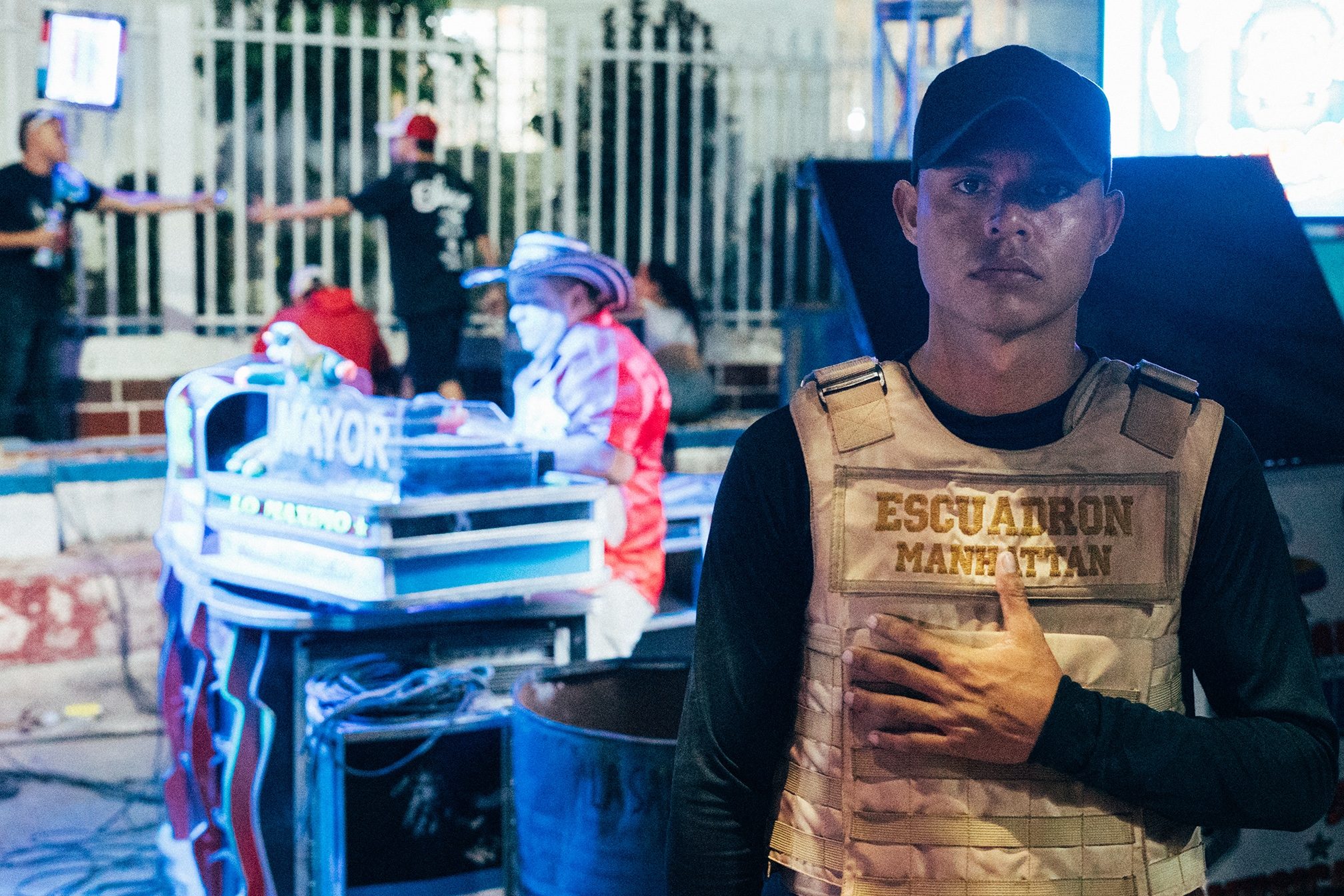
Champeta crackdowns
While picós quickly became central to the cultural identity of local communities in the barrio, for much of their history the sound systems and the musical genres closely linked to picó culture have faced crackdowns and opposition from the politicians and authorities in Colombia - who associated the scene with criminality and social problems.
Restrictions were introduced to try and reduce the number of street parties and, as recently as 2015, politicians in Cartagena’s district council were campaigning to ban champeta dancing in public places claiming that the music incited teenage pregnancy.
Despite repeated attempts to suppress picó culture, it has continued to grow and today in the barrios of towns and cities on Colombia’s Caribbean coast it is almost inescapable. During weekdays there are brightly-painted picós on almost every street, playing out of corner shops, pool halls, and people’s houses. At the weekend, giant picó sound systems are wheeled out onto the streets, sometimes playing day and night in famous music-loving barrios like Pescaito in Santa Marta.
Read this next: Reclaiming Medellín from gang rule has transformed the Colombian city's music scene
Fans of bass-heavy music congregate at street parties as well as piling into informal bars known as “patios” where picoteros participate in sound clashes, each taking turns to try and outdo each other by unleashing a sonic bombardment on the audience. Colombia’s coastal barrios are full of stories of iconic exclusivos, legendary soundclashes, and heroic picoteros.
In bars, drinkers will often tell you how their father or uncle spent hundreds of dollars travelling to Africa in the ’70s in pursuit of rare vinyl – so they could defeat their rivals in sound clashes.
In cafés, grandmothers will tell you about how the legendary picotero Arnulfo Alvarez was murdered by a sleep-deprived neighbour because he refused to stop blasting tunes from his sound system outside his house day and night. Or how, in the ’80s, traditionalists used to protest against picós that used sampling keyboards by bringing signs that said “No piano!” to parties.
Taxi drivers will regale you with stories about the tussle for dominance between El Dragon and El Gran Lobo in Barranquilla in the early 2000s. Children in the street will tell you about the meteoric rise of El Super Kike.
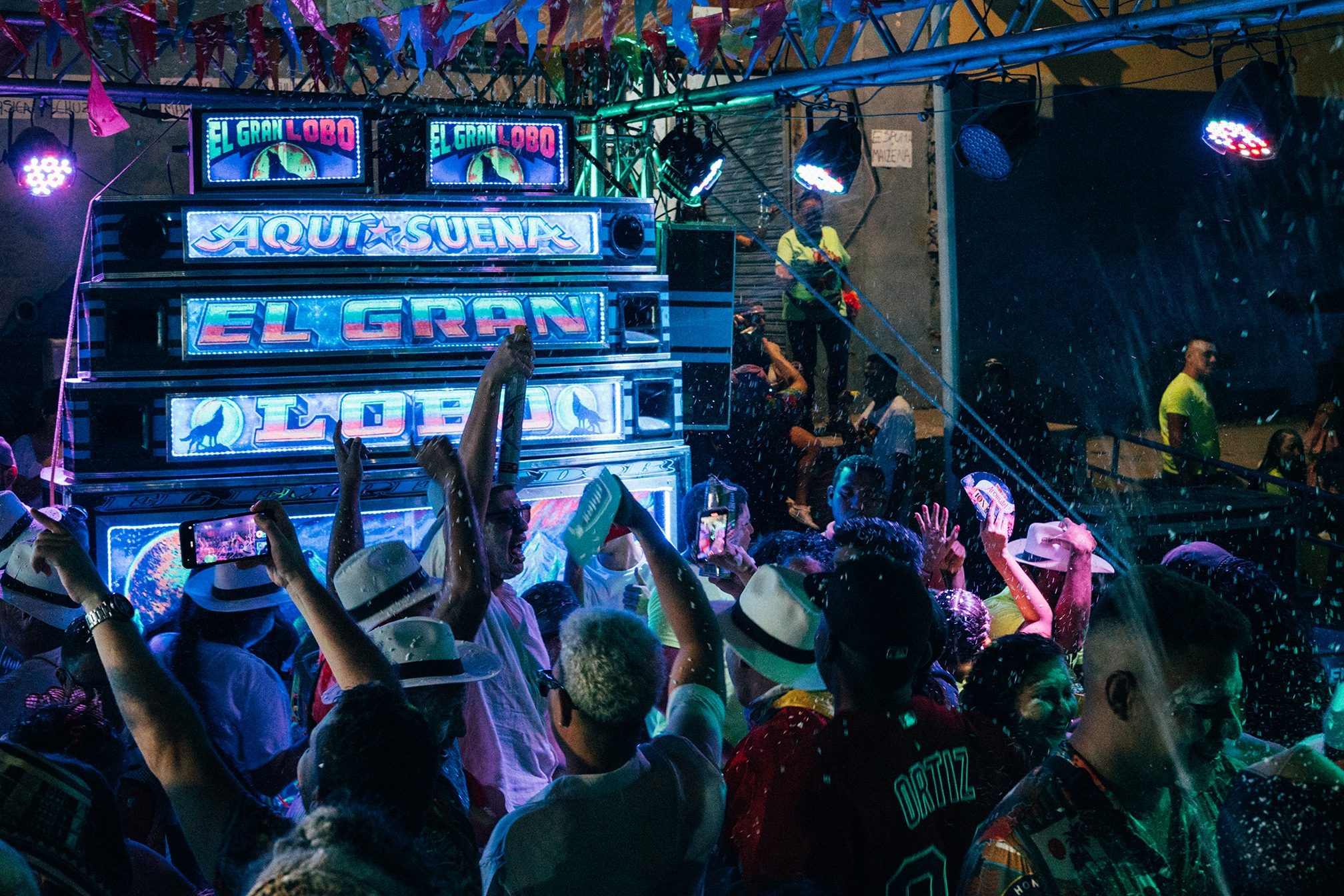
Coastal obsession
Today, the competition remains intense between Colombia’s coastal sound systems, according to Mundy Turbo’s Any La Pechy, one of the few female sound system founders in Barranquilla.
“If you are playing in a sound clash or even just playing out on your street on a Saturday afternoon - you are battling for respect,” she says. “Picoteros want to show their skills at selection. They want to showcase their exclusivos and the power of the sound system – and they want to get the crowd dancing like crazy.
“Every picotero wants to have the most famous sound system in their barrio. Then once they have that - they want to be the most famous in their city.
“Then, when they are number one in their city, it’s a full-time job staying at the top – because there are hundreds of other sound systems out there that want to take your place.”
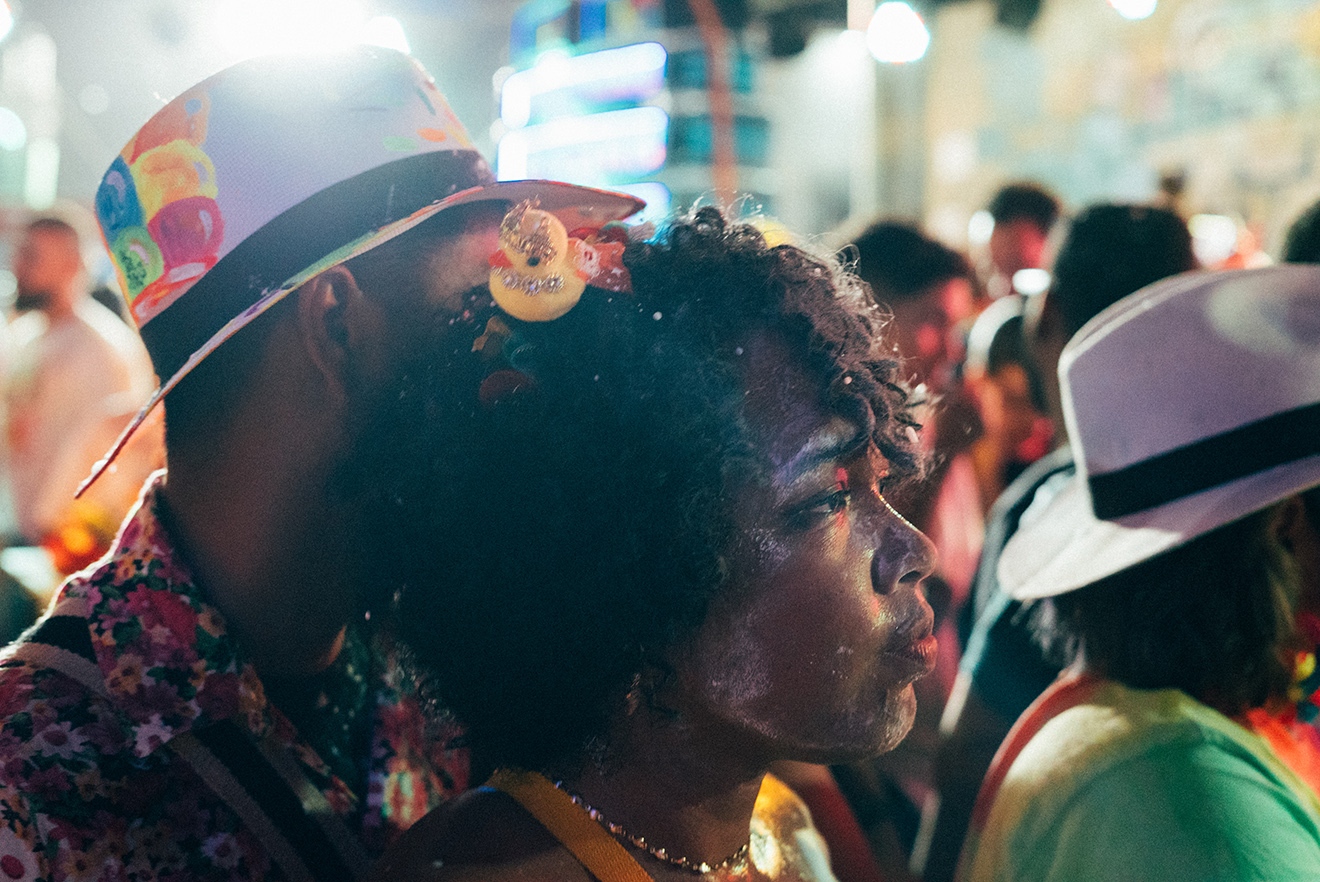
One way of understanding the value that people put on sound system culture in the coastal cities of Colombia is to look at the sums of money being spent on them, according to Toni Celia Maestre, the Director of Art and Culture at Barranquilla’s Universidad del Norte.
“Each of the speaker stacks used by the bigger sound systems will cost literally tens of thousands of dollars,” he says. “In many cases, when you visit the homes of some picoteros, you realise that these people are happy to pour huge amounts of money into their sound systems while they are actually living in very humble circumstances, or even living in debt.
“For a lot of people living on the coast of Colombia this really is an obsession that people from other countries would probably find it hard to understand.”
Read this next: Children of the original travelling soundsystem DJs are upholding their parents' legacy
Bclip, a multi-genre producer and performer who grew up in the midst of Barranquilla’s picó culture, agrees that picó culture is difficult for North Americans and Europeans to understand. “If you live in a town in England and your neighbour is playing music all night that is so loud that it is vibrating your whole house – you would probably be annoyed and call the police,” he considers. “But here, in a lot of barrios, people love music so much – it’s a source of pride if you have a powerful picó that is active on your street.”
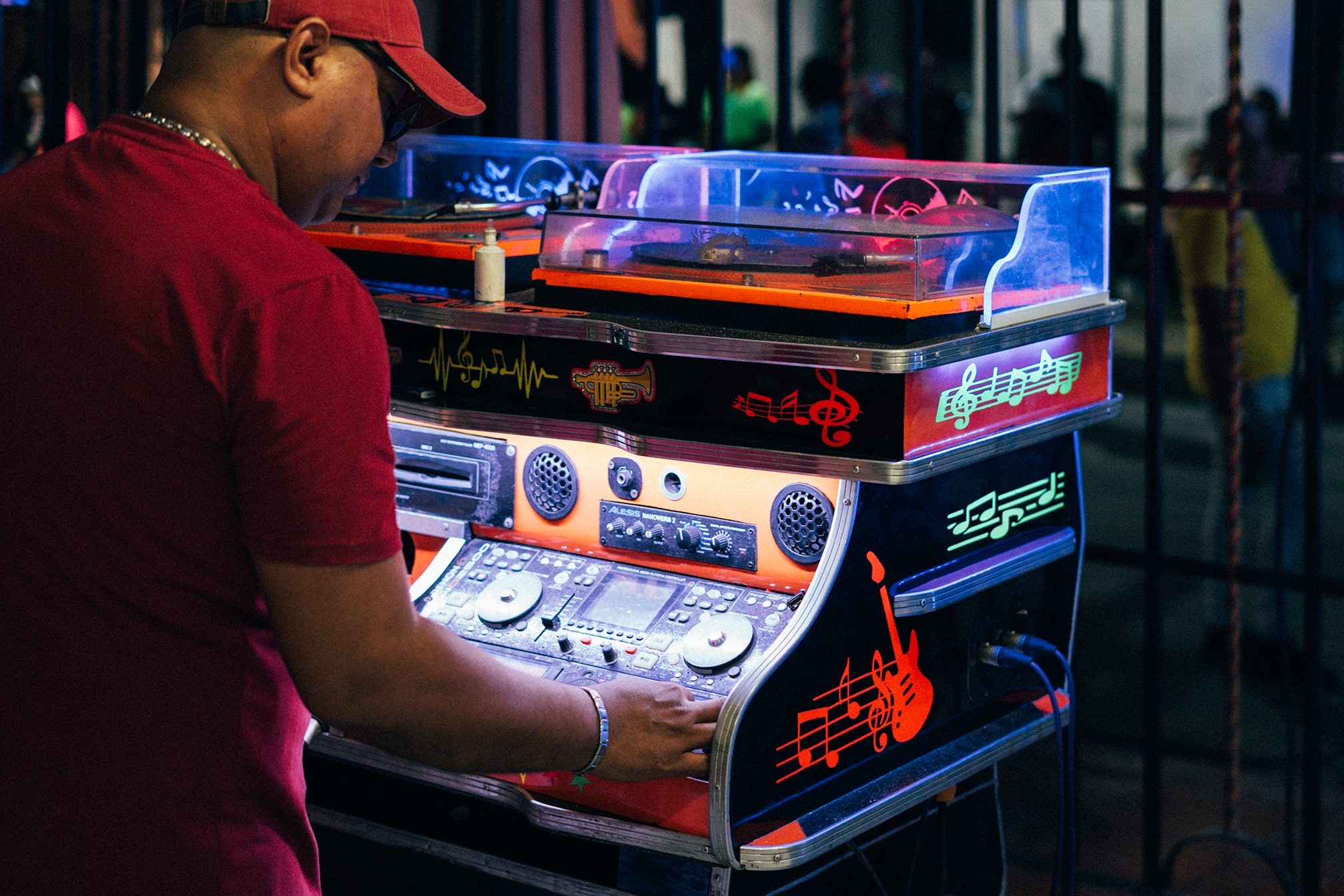
Barrio superstar
On Carrera 50, standing under bright lights, on a stage between two giant speaker stacks of El Super Kike, the DJ and tastemaker that founded the sound system, Maikol El Insoportable (Maikol The Insufferable), is behind the decks. He is singing into a microphone while he plays out the ’90s champeta hit ‘La Vuelta’ by Anne Zwing. Next to him, the 23-year-old finger-drumming prodigy El Intelecto is hammering away, improvising on an Akai MPC Live II, which he has pre-loaded with an array of samples from a Casio SK-5 keyboard.
El Super Kike’s two huge speaker stacks are each emblazoned with the word “Kike” in neon orange and green paint as well as a giant image of the No-Ghosts logo Ghostbusters wearing a gold chain around his neck, which has become the adopted logo of sound system.
In the densely packed crowd in front of the speaker stacks, some revellers are forming circles and taking turns to dance in the centre, either individually or in pairs. Dancing to champeta frequently involves fast shuffling footwork as well as occasional dramatic manoeuvres, like dropping to a sitting position or lying prone on the floor.
In one circle, a pair of girls both wearing cut-off denim shorts are rotating their hips against each other and swaying their knees as they perform distinctive champeta dance moves while being pelted by handfuls of maize flour and splashes of aguardiente.
Suddenly, El Intelecto stops battering the pads of his MPC and Maikol shouts in the microphone: “If you are going to throw maize flour, throw it immediately! I want to see everyone jumping – jumping in maize flour!” He starts to play ‘Me Vale’, a ’90s ska punk tune by the Mexican band Maná, and the circles of champeta dancing disintegrate into a sea of skanking and clouds of white maize flour.

Turbo bass
After the cultural split in the late ’80s, the two main types of picós in Colombia’s Caribbean coast generally became divided between the more traditional “turbo” style, like El Gran Lobo, and the “fraccionados”, like El Super Kike. While the two styles of sound system have had intense rivalries during certain eras, they both transform the recorded music that they play into a unique live experience.
For the fraccionados, it is normal for picoteros to improvise over the top of tracks using keyboards, electronic drums, samplers, and live vocals. This makes playing a classic champeta tune, like ‘La Vuelta’, into something entirely new and different for the live audience.
For the more traditional turbos – the transformation is slightly more subtle – but can, at times, be equally intense. Turbos are usually set up with one or more large towers at the front of the dancefloor, each consisting of an array of massive bass speakers installed into a huge, ornately painted cabinet with mids and tops built in above.
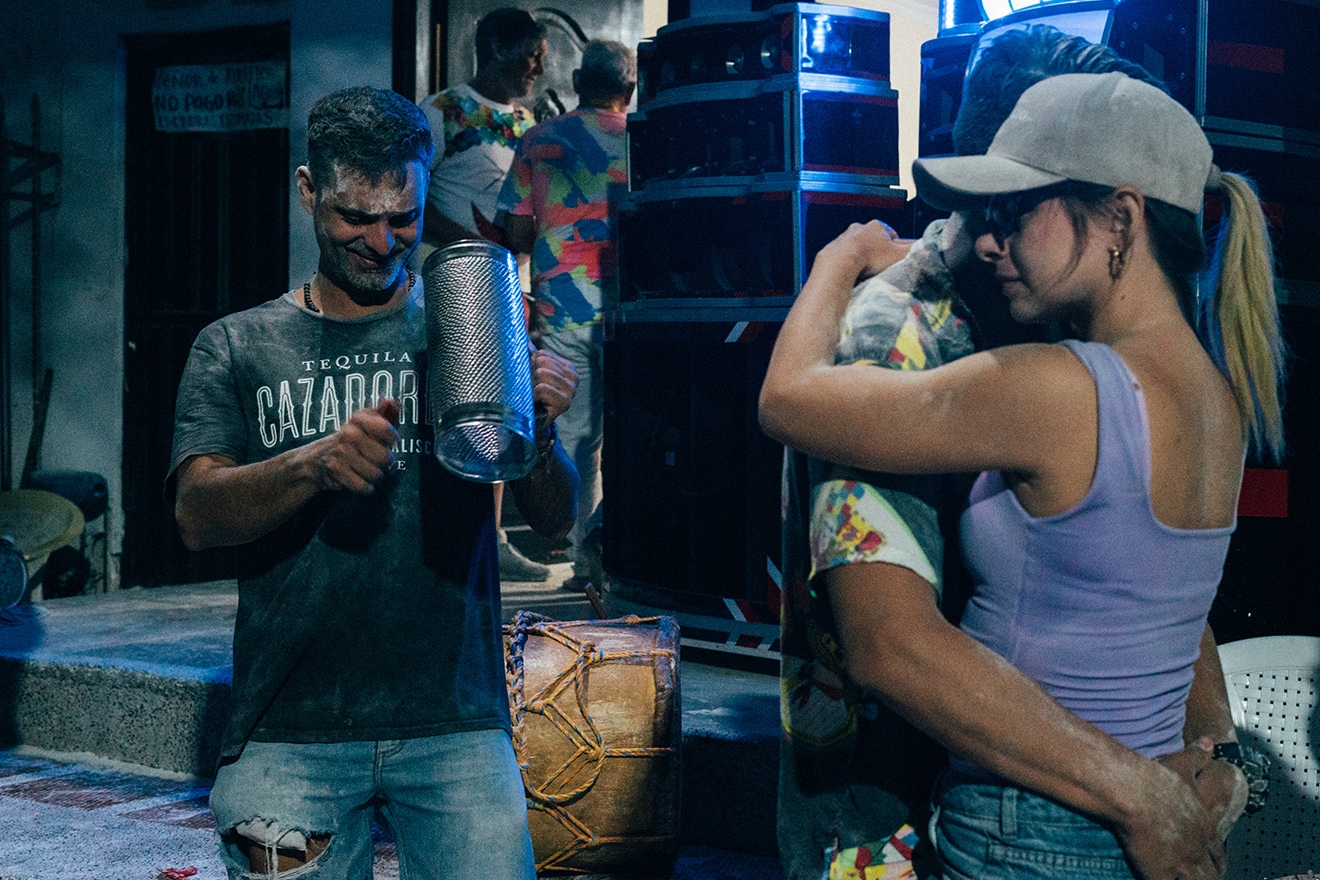
As well as the main stacks at the front of the dancefloor – other supplementary speakers will normally be spread around the party – often tied to trees and lampposts or attached to balconies of nearby houses. The immensely powerful bass speakers of the turbos mean that often the records played on these sound systems will sound very different to the normal listening experience.
Bclip says: “The obsession with powerful bass means that listening to something like a classic salsa tune on a Colombian turbo is a completely different experience to a normal salsa experience.
“All of the frequencies are stripped out, divided and coming at you from different directions at different volumes.
“Sometimes the bass is overwhelming and almost the only thing that you can hear or feel.
“The arrangement of the speakers and the amplification of the bass means that the act of playing a tune through a turbo creates a sort of remix, or reinterpretation, of the original tune in a way that none of the original musicians intended for it to be heard.”
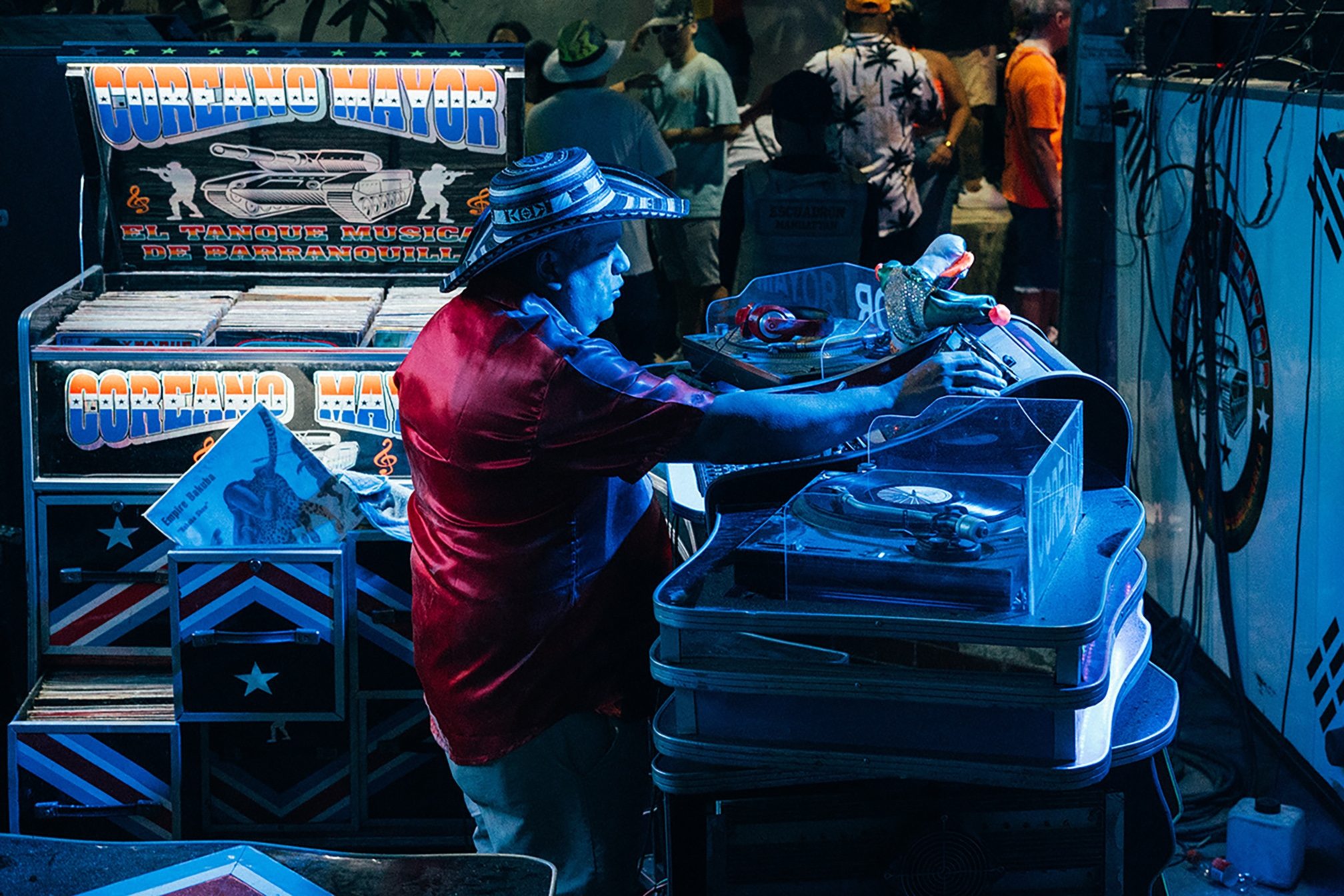
Kings of the old school
Just a stone’s throw away from El Super Kike on Carrera 50, DJ Matamba Muñoz is in control of the El Gran Lobo sound system. In the eye of a musical hurricane, DJ Matamba is sheltering at ground level behind the sound system’s right-hand speaker stack, a position that is almost impossible for most of the audience to see.
While fraccionados are more likely to play contemporary electronic tunes such as champeta urbana, guarapo, and reggeaton – turbos like El Gran Lobo are more likely to venture deeper into history for their selections. Matamba is rifling rapidly through genres, playing salsa, vallenato, soukous, and highlife.
Read this next: How sounds from the Global South stopped club culture stagnating
Like the crowd for El Super Kike, the revellers here are constantly throwing drinks and maize flour over each other – as well as spraying soapy foam from canisters. While he plays, Matamba’s Pioneer XDJ-Aero controller is totally wrapped in plastic film in order to protect it from a constant hail of beer, aguardiente, foam, and maize flour. Just the controller’s two faders are exposed through rips that have been made in the plastic film.
There is nothing to prevent people from touching the sound system or moving behind it - and there is a constant stream of revellers brushing past Matamba to climb onto some large concrete steps that are located behind the speaker stacks and thronged with unruly dancers.
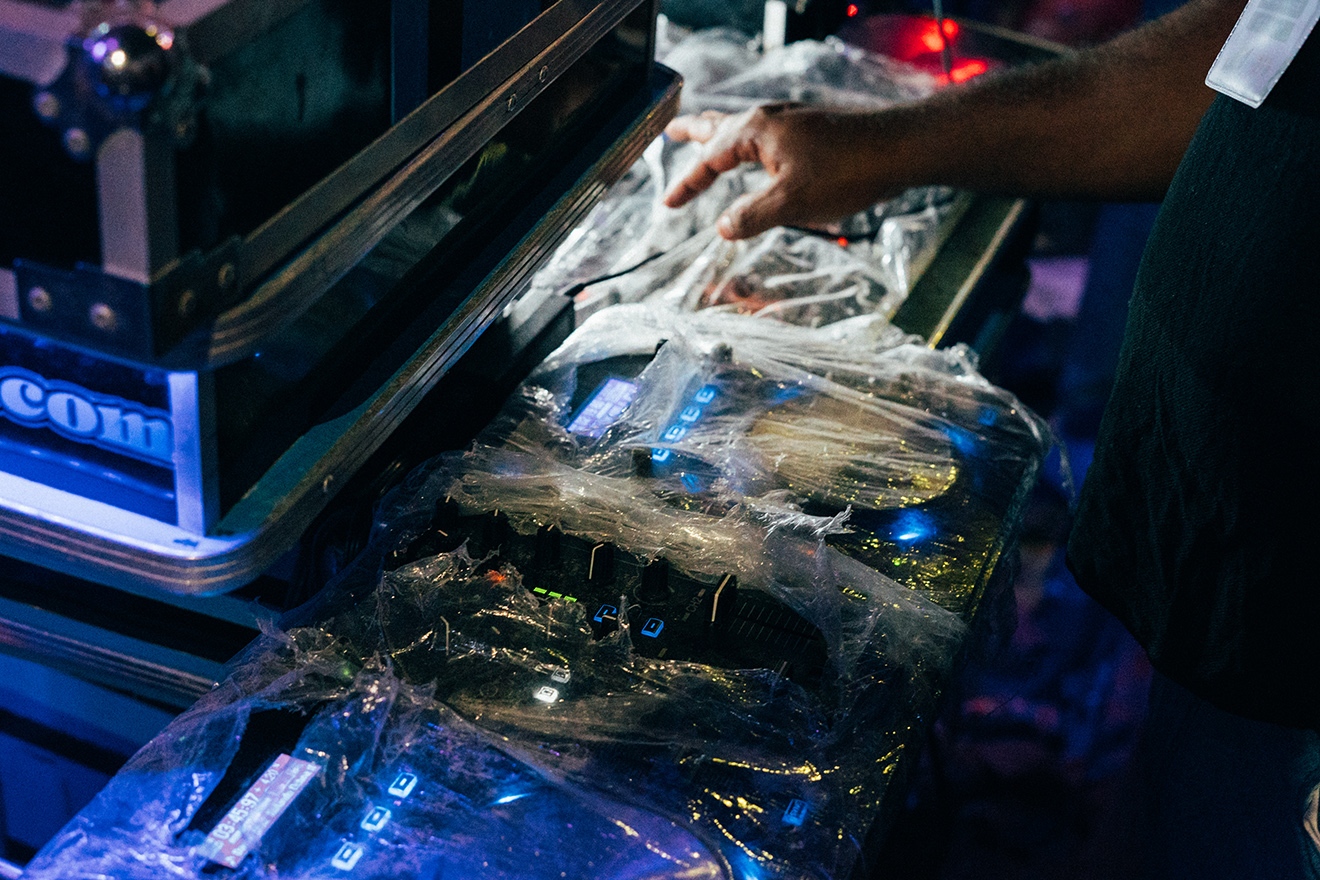
While Matamba is almost invisible to most of the crowd, the intricately decorated, turbo-charged El Grand Lobo sound system is unmissable. Two 12-foot tall cabinets stand, glowing with LED lights, at the front of the makeshift dancefloor. On each of the huge, back-lit grills of the sound system’s bass speakers there is an ornately airbrushed image of a wolf in a forest howling at the moon, painted by the iconic picó artist William Gutiérrez Peñaloza. The bass cabinets are rimmed by gleaming chrome and across the mids and tops it says “Aqui Suena El Gran Lobo” in neon green, white, and red.
As Matamba plays the salsa classic ‘Descarga Caliente’ by Rubén Blades and Pete Rodriguez the cranked up sound of the rolling double bass pulsates through the packed-out street.
A couple wearing tie-dye T-shirts are holding each other closely next to one of the giant speaker stacks and dancing with their eyes closed – oblivious to the chaotic thrashing and jostling of the raucous crowd all around them.
Suddenly, Matamba hits a button and the El Gran Lobo’s trademark wolf howl wails out of the sound system followed by the start of the '70s soukous tune 'Muinto Obrigado' by the Congolese band Empire Bakuba. The crowd greets the tune, which is known as 'El Cuco' in Barranquilla, with outbreaks of champeta dancing, shouting, explosions of maize flower, and foam.
As Matamba bombards the sweating crowd with hours of salsa, vallenato, zouk and soukous he positions his audience at the heart of a world where African and various Caribbean cultures are constantly colliding with Latin music.
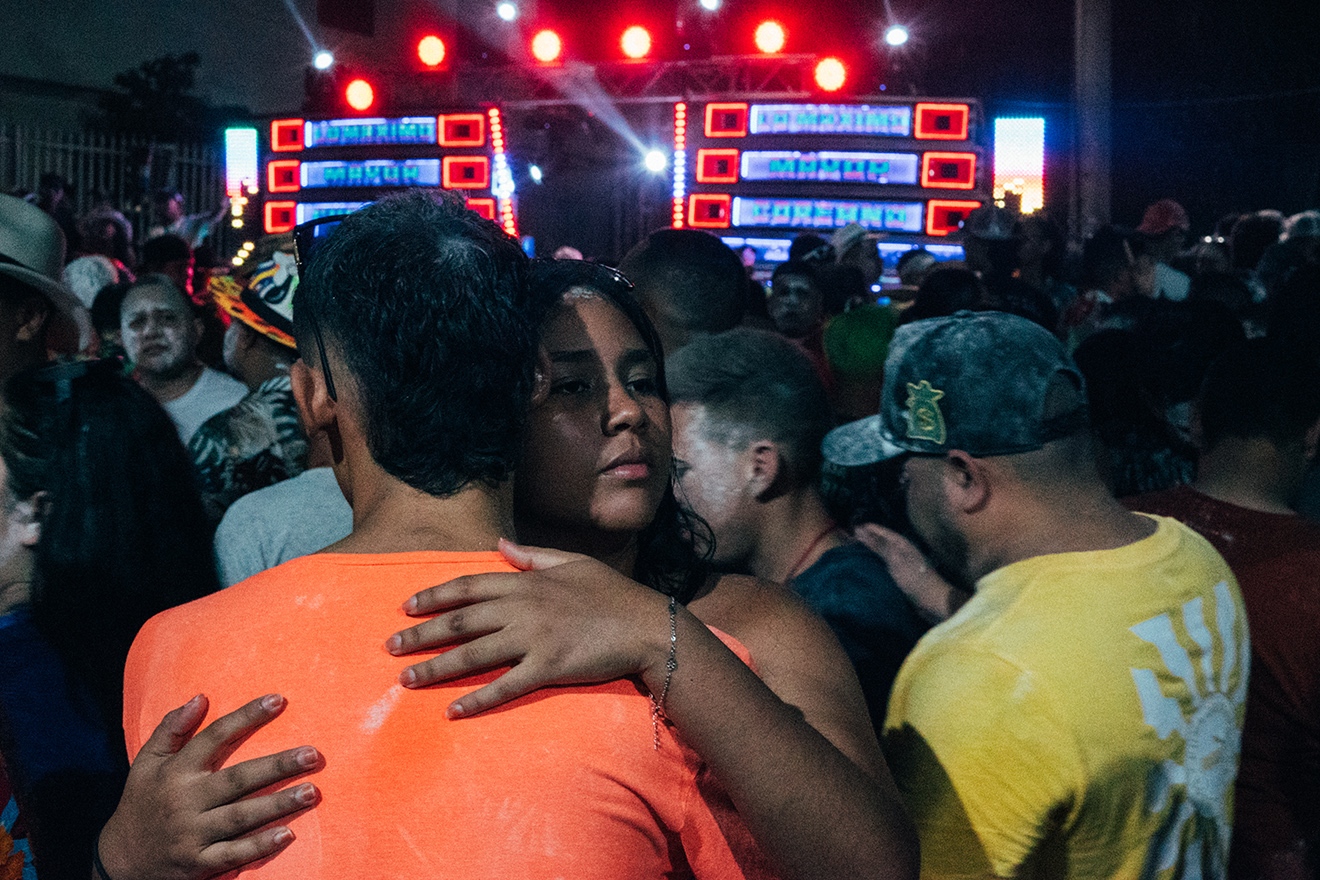
Brink of a breakthrough
El Super Kike’s Maikol El Insoportable and Julio Cesar Lobo, the founder of El Gran Lobo, both believe that the sound and culture they have dedicated their lives to could be on the brink of a breakthrough in terms of greater recognition, both at home and internationally.
Across the Caribbean coast of Colombia, the attitudes of the authorities and mainstream cultural institutions have started to change over recent years and the scene has garnered increased acceptance across all of the country’s social classes.
Groups that represent the picós of Santa Marta, Barranquilla, and Cartegena now have regular meetings with cultural officials in the cities to discuss how they can work together to ease restrictions on picós playing in public places.
“This is a culture that comes from the barrio, so in the past a lot of people considered it to have a low cultural value – but the situation is definitely improving,” says Julio. “We’re having positive conversations with people in the cultural department of the city council to try and make it easier for picoteros to get licences to put on legal events – so they don’t need to resort to unlicensed events in the barrios.
Read this next: Colombia to officially recognise cultural importance of Cumbia music
“City officials have realised that picós aren’t some sort of social problem – they are actually something that has cultural value and they have started to become much more supportive,” he adds. “They’ve seen how the tourists that come here love the unique vibes and parties that the picós create on the streets and in the patios.”
Other signs of changing attitudes to picó culture include an exhibition that was organised last year by Toni Celia Maestre in Barranquilla’s Centro Histórico to celebrate William Gutiérrez Peñaloza’s paintings on picó sound systems.
“A retrospective of the work of Peñaloza was well overdue,” says Toni. “There are literally thousands of these sound systems on the coast and they are deeply ingrained in daily life.
“Because of this, the people who create the images on them have actually had an incredible impact on the visual culture of the region - and this should be recognised in cultural spaces like art galleries.”
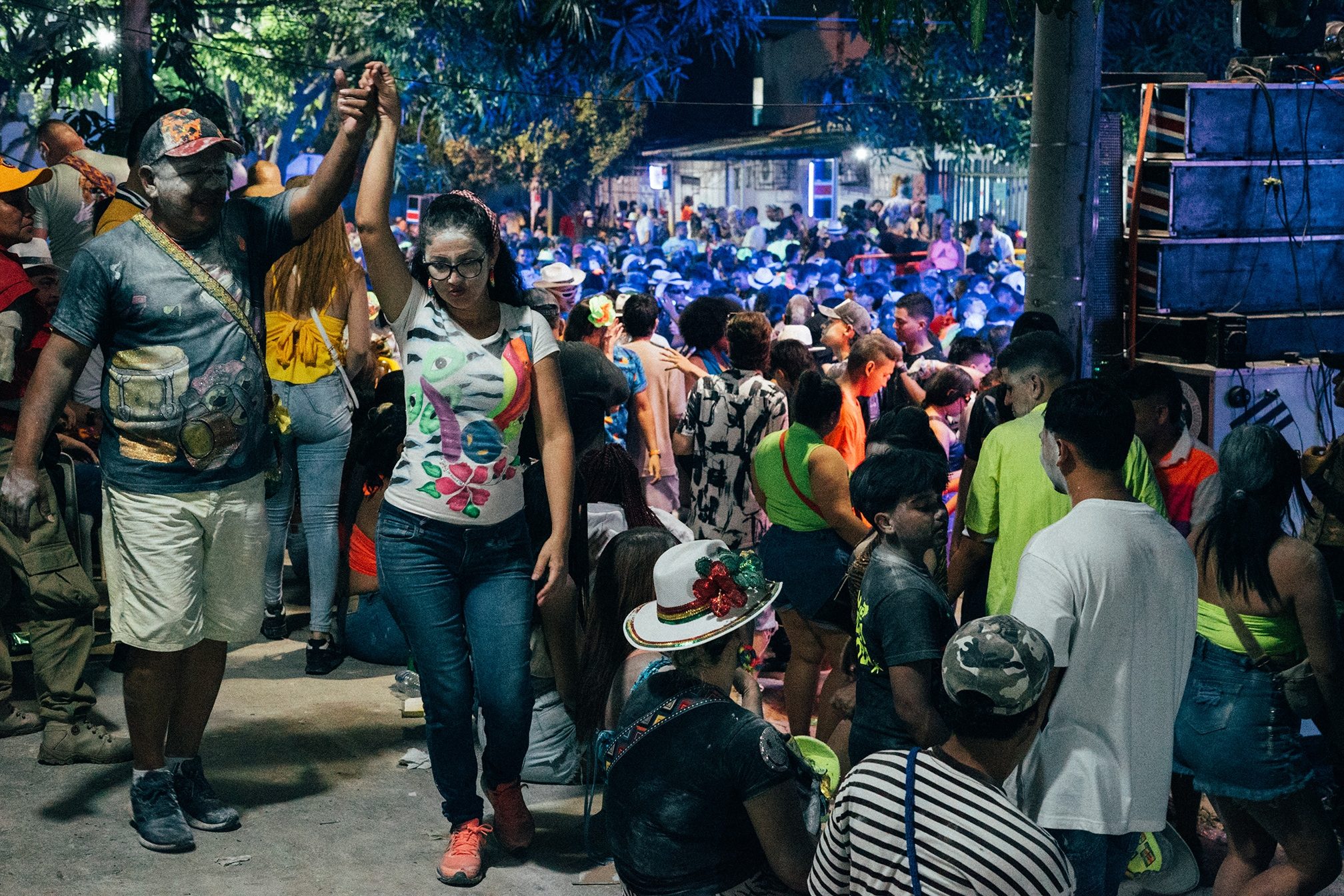
International reception
International interest in picó culture and its associated genres, such as champeta and guarapo, has also increased over recent years.
Picó DJs from Colombia’s Caribbean coast are touring more, and DJs from other countries are becoming increasingly interested in the music that is coming out of the region.
The Australian-built El Gran Mono, which was constructed in close consultation with Colombian picoteros, premiered in Melbourne in 2018 claiming to be the first genuine picó sound system to be constructed outside of Colombia.
Since then, Colombian picoteros say there has been an uptick in requests from overseas about sound system construction as more foreigners seek to replicate the authentic picó sound
Maikol believes that picó culture and the new music coming out of Baranquilla’s coastal cities is seeing increased interest from overseas because of changing international music-listening trends.
“Global interest in Latin genres like reggaeton has soared over recent years,” he says. “This has left people looking around at what other kinds of music are emerging from countries like Colombia.”
Maikol believes that it’s not just music fans that are looking around for different sounds. He says that because artists like Bad Bunny are making so much money, record label scouts are starting to take Latin genres much more seriously.
“Champeta has a much longer and deeper cultural history than reggaeton and, in my opinion, guarapo is probably even more effective than reggaeton when it comes to tearing up a dancefloor,” he says.
Read this next: New book highlights the pioneering Latin American women in electronic music
Producers of guarapo and champeta urbana that are coming out of the barrios of cities on the Caribbean coast are also benefitting from technological changes, according to Julio Cesar Lobo, who is the director of Barranquilla’s Radio Tiempo radio station as well as being the founder of El Gran Lobo.
“In the past, the young people who were producing these tunes didn’t have access to the best equipment,” he says. “While the raw-sounding tunes they made were effective in a street party – the poor sound quality would put off international audiences – and often these tunes wouldn’t even be considered to be played on local radio stations.
“Over recent years, the equipment needed to make high-quality records has become a lot cheaper and we’ve seen these bedroom producers start to make tunes with much higher production values.”
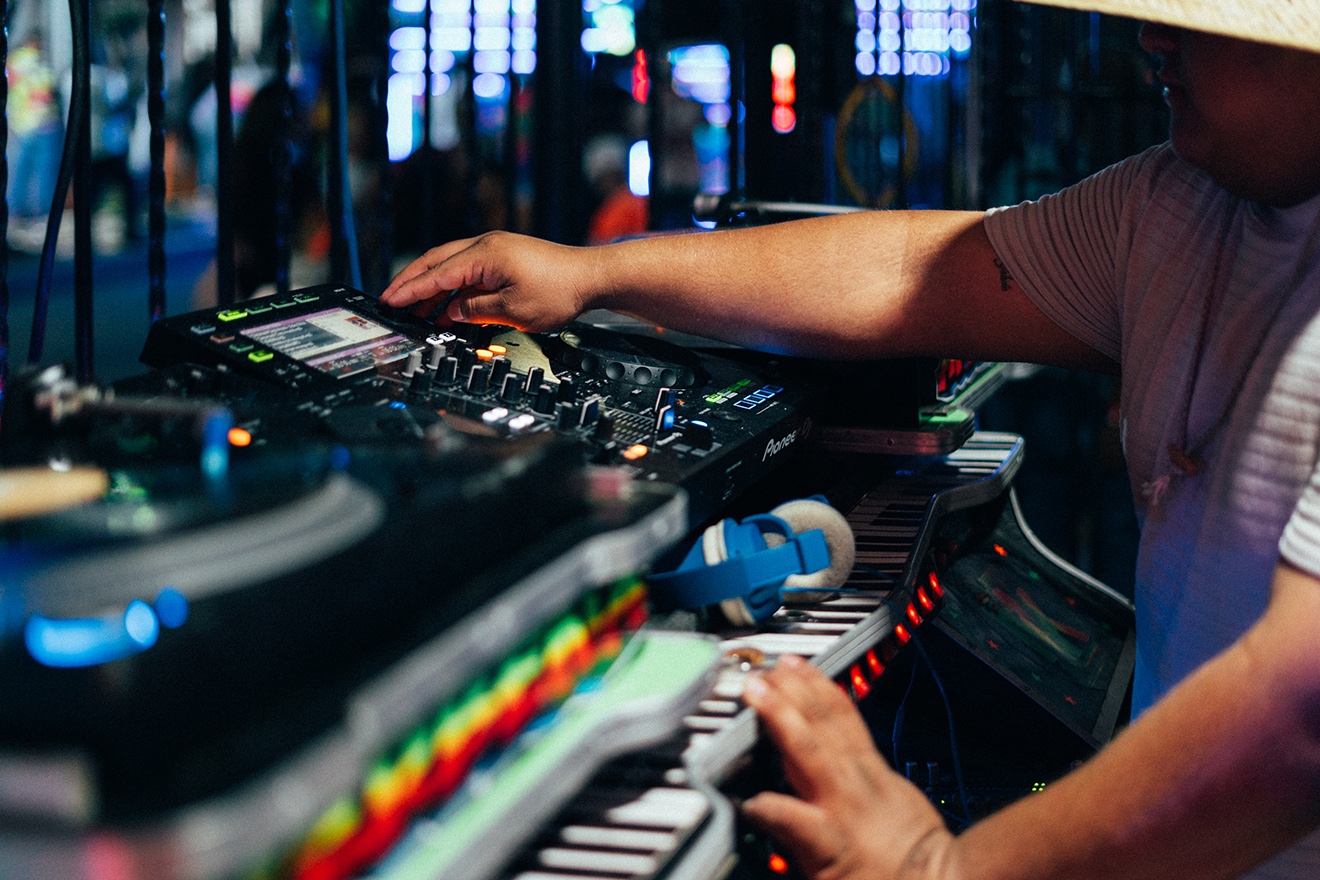
Understanding guarapo
Due to the fiercely localised nature of Colombia’s picó culture, the contemporary champeta urbana and guarapo music that is being made on the Caribbean coast is sometimes viewed as a musical product that outsiders won’t be able to properly understand.
Picó sound systems very rarely mix records and often picoteros like to quickly jump between radically different genres and rhythms.
Read this next: Video games are influencing a generation of electronic innovators
A modern gurapo tune like Maikol’s 'La Blanquita', which was released earlier this year, is in some ways, a distillation of picó culture, and can be an extremely strange listening experience to the uninitiated – potentially sounding more like an abstract art project than music made for a dancefloor.
'La Blanquita' has a juddering and grinding, off-kilter 6/8 rhythm with Maikol and Neider Perreo, another guarapo artist, rapping over a beat made with, what sounds like, a retro video game sound palate.
Toni Celia Maestre believes that the popularity of guarapo is more likely to slowly increase over coming years rather than exploding in popularity on a global level in a short space of time.
“This isn’t club music for people on molly that want to keep the same groove all night long,” he says. “This is music that keeps you on your toes and is constantly changing and giving you different looks and vibes every couple of minutes.”
Picó culture on tour
Bclip is currently one of the most active Colombian DJs that is promoting picó culture on an international level – and he agrees with Toni that genres like guarapo won’t be everyone’s idea of a dancefloor filler.
“The best thing about modern champeta and guarapo is that it builds on a very rich and deep musical history,” says Bclip. “But this is also the thing that makes it so hard for outsiders to understand and enjoy.
“African music first came to Colombia’s Caribbean coast with the slave ships in the 16th century and it has been fermenting here ever since.
“It’s been mixing and evolving with Latin sounds, folk music, and tropical flavours for literally hundreds of years – and genres like guarapo are a direct result of this process.”

The next generation
When Bclip plays international festivals he still represents his origins in Barranquilla’s picó scene, even though a lot of the records he plays wouldn’t normally be heard at a street party in the barrio.
“I might be mixing house and techno and have a lot of Western influences – but I often change the genre and vibe in an instant just like a picotero,” he says.
Bclip also finger drums on a Casio SK-5 keyboard and includes guarapo and other genres closely associated with picó culture when he is playing sets overseas.
At the moment, Bclip is regularly playing his hard house edit of the 1984 guaracha tune ‘No Me Maten’ by Dolcey Gutierrez in his sets. “It’s a carnival anthem that will always get the dancefloor going crazy in Barranquilla, but when you are playing this tune in another country it’s a lot harder to get the same impact,” he says. “The tune is super-fast at 168 BPM – which makes it difficult to weave it into a set.
“Often when you play a record that is very deeply ingrained in the culture of Colombia’s Caribbean coast it has to be framed in a very specific way to make it work in a set in somewhere like Berlin.”
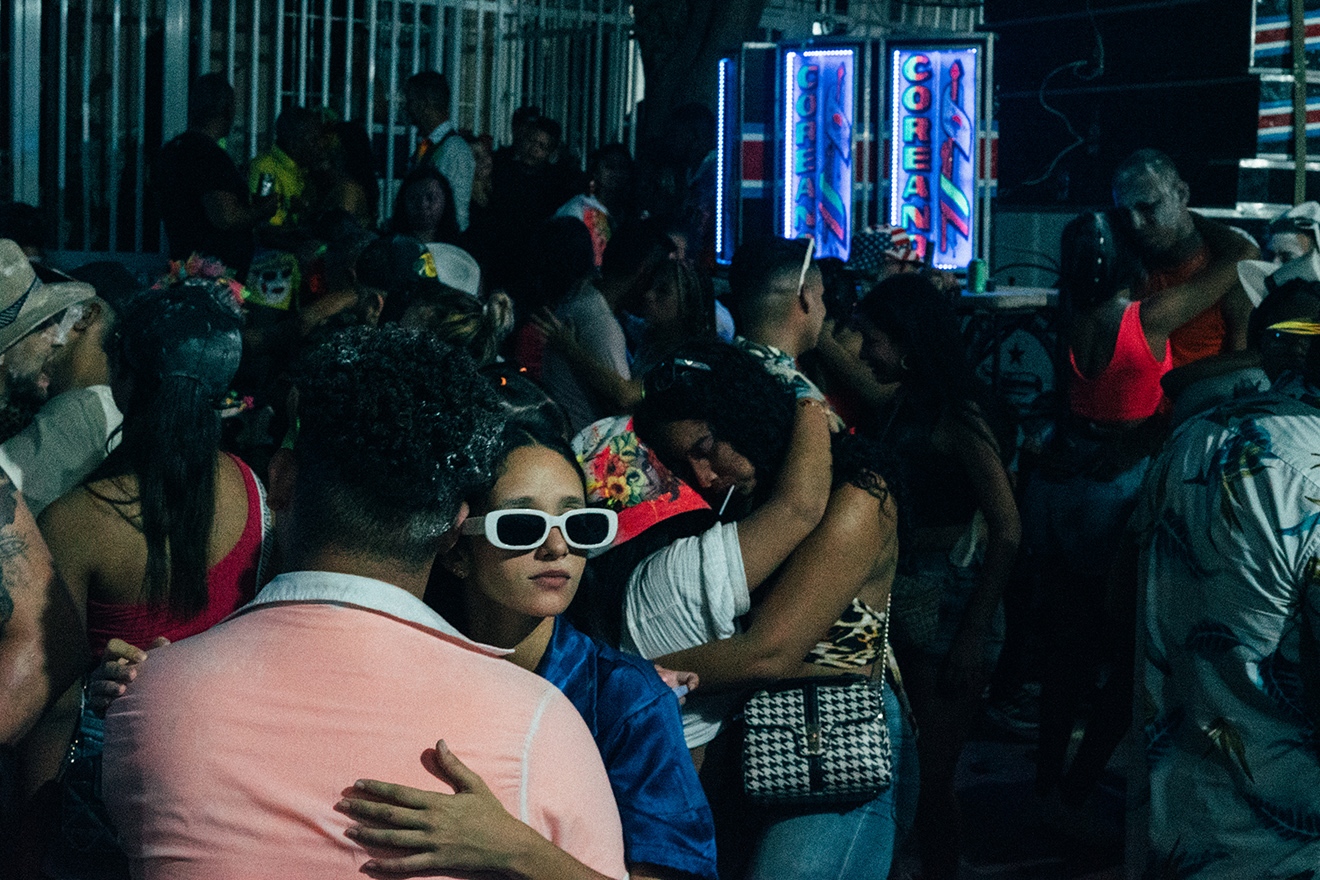
While Maikol believes that guarapo and champeta urbana is set to grow in popularity internationally over coming years – he says he won’t be disappointed if he doesn’t become more well known overseas. “I don’t listen to any Western music,” he says. “Latin America and Africa already have too many amazing genres and too many great records for me to listen to them all.
“Of course I would like more people to listen to the music that I’m making with El Super Kike - but when we are making music we aren’t thinking about what people in Europe are going to like or dislike.
“We are making music for the people in our communities and for the rest of the Caribbean coast who share our history and our musical passions.”
Whether or not genres like guarapo and champeta urbana do find more commercial success internationally over coming years remains to be seen, but one thing is not in doubt: the picó scenes in Cartegena, Santa Marta, and Barranquilla are going to continue to expand and evolve.
A new generation of Colombians are already growing up within the culture. They are weaving in new ideas and technologies that build on the region’s deep musical heritage and past innovations.
The clampdowns and sanctions of the past did little to stop the scene from flourishing, and now that local authorities are taking action to support the culture it is likely to grow even more rapidly.
Wil Crisp is a freelance journalist, follow him on Twitter


